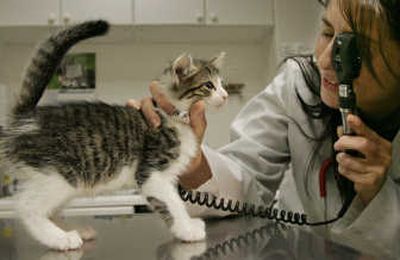Feline leukemia cases decline

The good news about the Feline Leukemia Virus (FeLV) is now that kittens are routinely tested for it and vaccinated against it, the virus has declined in prevalance.
FeLV is a retrovirus (like HIV), but it can infect only domestic and wild cats. Cats can carry this virus without showing any signs of illness, and they can spread the virus to other cats. The virus is found in the saliva of FeLV-positive cats, so cats grooming one another or sharing food bowls can spread the virus. It is also found in the blood, so bites inflicted during fights can spread it, and pregnant cats can give it to their offspring.
Most cats who are exposed to the (FeLV) will mount a good immune response and be able to clear the virus from their bodies. However, a small percentage of the cats will not be able to fight it off. These cats may become persistently viremic, meaning the virus can be found in their blood and saliva, and they are contagious to other cats. Or the virus may enter the cat’s bone marrow where it can sit for years doing nothing. This is called a “latent” infection. These cats will test negative on routine FeLV tests, and they are not contagious because the virus isn’t in the blood or saliva. They could become sick years later, but, usually, they clear the infection without ever posing a threat to other cats.
The signs of FeLV infection can be pretty vague. The virus impairs the immune system, so infected cats are more susceptible to all sorts of infections and to certain cancers, especially leukemia or lymphoma. The virus commonly causes anemia, so you may notice lethargy, poor appetite, weight loss or pale gums. Sometimes these infections or cancers can be treated, but the virus itself will remain. In multicat households, 80 percent of FeLV positive cats die within three years of diagnosis.
What can you do to prevent this heartbreaking scenario? The most important thing is to have any new feline additions to the household tested for FeLV. The more cats in the household, the greater the chance of accidentally introducing an infected cat. If all your cats test negative, and if you prevent the possibility of exposure by keeping them indoors, you should not have to worry about this virus. There is also a vaccine against FeLV which is very helpful, but not 100 percent effective at preventing infection. That is why avoiding the possibility of exposure is most important.
The blood tests your vet can perform in the office are excellent, so if your cat’s test is negative you can breathe a sigh of relief. If it comes back positive, don’t panic. If your cat is healthy and the result is unexpected, it could easily be a false positive. Your vet will send another test to a lab to confirm the result. If your cat has an illness known to be associated with FeLV, or has had known exposure to a positive cat, then it is much more likely that the positive test is correct.
What can you do to help your FeLV infected cat? Ideally, an infected cat should not be housed with other cats, and should be indoors only. This reduces her exposure to opportunistic infections and protects other cats from contracting the virus. She should not receive any raw foods, and should continue to be vaccinated and have routine exams, bloodwork, and dental prophylaxis performed. Such cats can live for several years with the leukemia virus and feel fine.
Many immunostimulants have been tried on infected cats, but none has been proven to be effective. Some people feel human interferon may help, but cats often develop antibodies against it. Feline interferon is now available in Europe and Japan, but we need more information about it before we can determine if it has a role in managing cats with FeLV. While we may never find a cure for this virus, we can, with universal testing and by sequestering positive cats, make it a very rare tragedy.